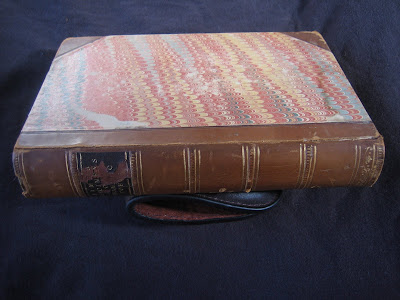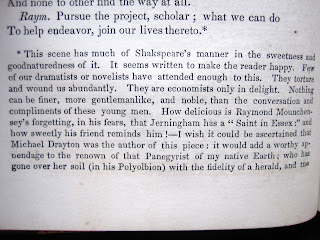

My brain this week is stuck in preparatory mode for my doctoral qualifying exams on Friday (yes, that’s right...Friday the 13th) and so this week’s book is related to my exam on the history of the book.
In my exam reading, one particular issue that has caught my attention within the field of editorial studies is the practice of anthologized editions -- how are they assembled and why, what is included and what is excluded, in what order is the material presented, and how are they used? One particular class of anthologized works is the “greatest hits” collection; usually an arbitrary selection of some material that the editor, in his or her subjective judgment, thinks is representative of the period in question.

This week’s book is a late American edition of English poet, critic, and essayist Charles Lamb’s classic of the anthologized Renaissance drama genre: Specimens of English Dramatic Poets Who Lived About the Time of Shakspeare [sic], With Notes. Lamb’s eclectic collection was first published by Longman, Hurst, Rees, and Orme of London in 1808. My copy was published by Willis P. Hazard of 190 Chestnut Street in Philadelphia, PA, in 1856. The title page bills the book as a “New Edition” and presents the contents of the original two-volume set in a single volume. It was printed by Philadelphia book and job printer Henry B. Ashmead, whose substantial, five-story shop was to be found on George Street just above Eleventh Street (that is, at today’s 1104 Sansom Street).

Lamb's book was one of the more popular of several nineteenth-century excursions into the drama of the sixteenth and seventeenth century, going through subsequent editions in London, Philadelphia, and New York in 1808, 1845, 1849, 1854, 1856, 1859, and throughout the twentieth century. As with most of the other anthologies of Renaissance drama from this time, the material selected is almost always couched in explanatory material demonstrating the superiority of Shakespeare -- though Lamb does claim that part of his objective was “[t]o show what we have slighted, while beyond all proportion we have cried up one or two favorite names” (a flaw that modern scholarship has still done relatively little to rectify).

The preface that Lamb provided to the first edition -- and that remained largely unchanged in all of the subsequent editions -- makes his intentions clear; it also indicates how unapologetically intrusive and judgmental the editor was in picking out parts of plays to present and modifying them to suite his tastes (and those, he presumed, of his readers) -- see the third paragraph of the preface in particular. As he puts it, his “leading design” was always “to illustrate what may be called the moral sense of our ancestors”, and he had no qualms about tidying up the texts (though, to be fair, he never goes quite as far as some infamous meddlers did).
The range of material Lamb has selected for inclusion is quite impressive: Thomas Sackville and Thomas Norton, Thomas Kyd, George Peele, Christopher Marlowe, Robert Tailor, Joseph Cooke, Thomas Dekker, John Webster, Anthony Brewer, John Marston, George Chapman, Thomas Heywood, Richard Brome, Thomas Middleton, William Rowley, John Ford, Cyril Tourneur, Samuel Daniel, Fulke Greville, Ben Jonson, Francis Beaumont, John Fletcher, Philip Massinger, James Shirley, Nathan Field, and the ever ubiquitous “Anonymous”. These writers represent a broad range of dramatic traditions (professional, academic, literary), a relatively wide period of time, and many different genres and styles.
Lamb’s style of presenting the works of these plays consists of selecting choice passages or scenes from various plays and presenting these passages with explanatory headers (often summarizing the passage’s “theme”), annotation including glossarial and critical footnotes, and added stage directions and explanations of action that has been skipped over. The overall effect is rather disjointed and the textual authority of the passages is highly corrupt, though as far as providing access to relatively obscure playwrights and their important works, Lamb did his contemporaries and many later readers a great service.

The pages measure 12cm x 18cm. Ashmead evidently carried out the printing by separating the two volumes into two separate jobs. The pagination of the first volume runs [i]-[xii] [1]-220 and the pagination of the second runs [v]-vi [1]-230; the lack of two leaves at the start of the second volume (that is, pages i-vi) suggests that a dividing, internal half-title and “flyleaf” was meant to be inserted but was for some removed before binding.
The book is printed in octavo, with numeric gathering signatures; on each signed page, there is also an indication of which volume the gathering belongs to (again, suggesting separate but likely simultaneous printing in Ashmead’s shop). The use of machine press seems likely because of the date and the scale of Ashmead’s operation, but the mechanization of the craft has unfortunately resulted in some problems with inking: the type on many pages is often under-inked, blurred, or scarred; indeed, sometimes one page in an opening will be visibly fainter than the facing page -- suggesting the outer and inner formes were being inked separately and not in synchronization.

The binding is a firm hardcover with marbled boards, a leather spine with gilt title, and leather corners. The spine is cracking slightly, especially along the front hinge, and the spine has some damage, but overall the condition is quite good. The only evidence of earlier readers consists of some faint pencil marks next to some of Lamb’s notes, two sentences in his preface, and the title of Ford’s The Broken Heart in the table of extracts in volume two. These may have been made by the same owner who pasted the “Underhill” family bookplate inside the front cover. The bookplate presents the family crest over a Latin phrase that I welcome help with: “Tibimet ipsi fidem praestato”.
Lamb’s book uses the ahistorical “greatest hits” methodology in anthologizing Renaissance drama, though it broadens the field considerably by drawing in a number of works that even most scholars today wouldn't bother reading. Lamb takes the practice to an even higher level of selective control by removing passages from their context and presenting only “extracts”.

This was something that certainly appealed to Lamb’s own predilections as a poet (rather than a scholar, historian, or theatre practitioner) -- he desperately wanted to believe in the discrete, detachable, and discernible nature of poetic genius and its products. Indeed, the practice did not die in the nineteenth century; at least one prominent twentieth-century poet took it up himself to adjudicate on the “essential” poetry of Shakespeare, removing the passages rather brutally from their appropriate dramatic context in so doing.


No comments:
Post a Comment